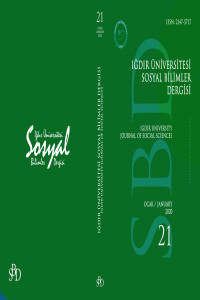Konya Bölge Yazma Eserler Kütüphanesi’nde Bulunan 5784 Envanter Numarası ile Kayıtlı Mushaf’ın Tezyini Açıdan Değerlendirilmesi
Abstract
Geleneksel Türk Süsleme Sanatları köklü tarihimiz boyunca gelişme göstererek günümüze kadar ulaşmıştır. Şüphesiz bu sanatlar içinde en önemli olanlardan birisi de tezhip sanatıdır. Tezhip sanatı kendi mahiyetinde birçok şekilde uygulanmasının yanı sıra yazma eserlerde de yazının güzelliğine ve düzenine estetik bir değer ve zarafet katmıştır. Okuyucunun göz zevkine hitap ederek sayfaları doldurmuştur. Bu çalışmanın konusu “Konya Bölge Yazma Eserler Kütüphanesi’nde bulunan ‘5784’ envanter numaralı Kur’ân-ı Kerim’in tezhiplenmiş sayfaları ve cilt kapakları” dır. Eserin ketebe sayfasından “Ahmed İbn Bahti Hoca” tarafından XVI. yüzyılda, Sultan Bâyezıd döneminde yazıldığı bilgisine ulaşıyoruz. Tezyinat yapılmış sayfaların bazı bölümlerinde tahribat meydana gelmiş olsa da büyük bir kısmı orijinal halini korumaktadır. Günümüze kadar bozulmadan ulaşan tezhipli kısımları desen, motif, renk, yazı mürekkebi, tasarımlardaki uyum ve kullanılan teknik bakımından incelenmiştir. Yazıldığı dönemin tezyinatı hakkında bilgi verilmiş ve eser görsel malzemelerle desteklenerek değerlendirilmiştir.
References
- Ayverdi, İlhan, Misalli Büyük Türkçe Sözlük. İstanbul: Kubbealtı Neşri- yatı, 2005.
- Baysal, A. Fuat., “Mushaf Tezyinatının Tarih İçindeki Gelişimi”, Mari- fe, 10/ 3, (Kış 2010), s. 365-386.
- Birol, İnci A., Türk Tezyînî Sanatlarında Desen Tasarımı, Çizim Tekniği ve Çeşitleri, İstanbul: Kubbealtı Neşriyatı, 2008.
- Celasin Tanrıver, Ayşe, XVI.. Yüzyıl Mushaf Güllerinin Süleymaniye Kütüphanesi’nde Bulunan Üç Kur’an-ı Kerim Kapsamında İncelenmesi, Süleyman Demirel Üniversitesi Sosyal Bilimler Enstitüsü Dergisi, 17, (1-13), s. 101-117.
- Derman, F. Çiçek, “Türk Tezhip Sanatının Asırlar İçinde Değişimi”, Türkler, (Ankara, Yeni Türkiye Yayınları, 2002), 12, s. 289-299.
- Derman, Uğur, “Kitap Sanatları”, Yüzyıllar Boyunca Türk Sanatı (14. Yy), Hzr: Oktay Aslanapa, (Ankara: Milli Eğitim Bakanlığı, 1977), s. 56-60.
- Küpeli, Gülnihal, “II. Bayezid Dönemi Tezhip Sanatı”, Marmara Üniver- sitesi Güzel Sanatlar Enstitüsü Geleneksel Türk El Sanatları Ana- sanat Dalı Tezhip-Süsleme Sanat Dalı, (yayımlanmamış sanatta yeterlik tezi), İstanbul, 2007.
- Meriç, Rıfkı, M., “Bâyezid Câmii Mimârı Sultan II. Bâyezid Devri Mimârları ile Bazı Binaları, Bâyezid Camii ile Alâkalı Hususlar San’atkârlar ve Eserleri” Yıllık Araştırmaları Dergisi, (1957) C.II., Ankara Üniversitesi İlahiyat Fakültesi Türk ve İslam Sanatları Enstitüsü, Ankara, 1958.
- Özen Esiner, Mine, Tezhip Sanatından Örnekler İstanbul: Prestij Yayınla- rı, 2007.
- Özkeçeci, İlhan, “Kur’an Tezhiplerinin Tarihi Gelişim İçinde Estetik Değerlendirilmesi”, Dokuz Eylül Üniversitesi Güzel Sanatlar Fakül- tesi Geleneksel Türk El Sanatları Bölümü 8. Ulusal El Sanatları Sem- pozyumu, s. 344-351, İzmir, 2002.
- Serin, Muhittin, Hat Sanatı ve Meşhur Hattatlar, İstanbul, Kubbealtı Neşriyat, 2003.
- Tanındı, Zeren, “Kitap ve cildi”, Osmanlı Uygarlığı, 2, 841-863, İstanbul: Kültür Bakanlığı Yayınları, 2004.
- Varol Atalay, Şennur, “Konya Mevlânâ Müzesi’nde Bulunan “12” Envanter Numaralı Kur’an-I Kerim’in Tezhip Açısından Değer- lendirilmesi”, Kalemişi, 4/8, (2016), s. 107-140.
- Yağmurlu, Haydar, “Tezhip Sanatında Genel Açıklamalar ve Topkapı Sarayı Müzesi Kütüphanesinde İmzalı Eserleri Bulunan Tezhip Ustaları”, Türk Etnografya Dergisi, S.13, İstanbul, 1973, s.79-117.
Evaluation of the Registration of Mushaf Registered with the 5784 Inventory Number in the Konya Regional Manuscripts Library
Abstract
Traditional Turkish Decoration Arts have survived to our day by developing throughout our history. Undoubtedly, one of the most important of these arts is the art of illumination. In addition to the application of illumination art in many ways in its nature, it has also added aesthetics and elegance to the beauty and order of writing. She filled in pages by addressing the reader's pleasures. The subject of this study is “The illuminated pages and skin covers of the Holy Qur'an numbered ’5784’ in the Konya Regional Literary Works Library”. From the colophon page of the work, we find out that it was written by Ahmed İbn Bahti Hoca in the 16th century, during the reign of Sultan Bâyezid. Although some parts of the constructed pages have been damaged, most of them remain in their original condition. The gilded parts of the wall, which have reached the present day without any deterioration, have been examined in terms of patterns, motifs, colors, writing ink, harmony in the designs and the technique used. Information about the decoration of the period was given and the work has been evaluated with visual materials.
References
- Ayverdi, İlhan, Misalli Büyük Türkçe Sözlük. İstanbul: Kubbealtı Neşri- yatı, 2005.
- Baysal, A. Fuat., “Mushaf Tezyinatının Tarih İçindeki Gelişimi”, Mari- fe, 10/ 3, (Kış 2010), s. 365-386.
- Birol, İnci A., Türk Tezyînî Sanatlarında Desen Tasarımı, Çizim Tekniği ve Çeşitleri, İstanbul: Kubbealtı Neşriyatı, 2008.
- Celasin Tanrıver, Ayşe, XVI.. Yüzyıl Mushaf Güllerinin Süleymaniye Kütüphanesi’nde Bulunan Üç Kur’an-ı Kerim Kapsamında İncelenmesi, Süleyman Demirel Üniversitesi Sosyal Bilimler Enstitüsü Dergisi, 17, (1-13), s. 101-117.
- Derman, F. Çiçek, “Türk Tezhip Sanatının Asırlar İçinde Değişimi”, Türkler, (Ankara, Yeni Türkiye Yayınları, 2002), 12, s. 289-299.
- Derman, Uğur, “Kitap Sanatları”, Yüzyıllar Boyunca Türk Sanatı (14. Yy), Hzr: Oktay Aslanapa, (Ankara: Milli Eğitim Bakanlığı, 1977), s. 56-60.
- Küpeli, Gülnihal, “II. Bayezid Dönemi Tezhip Sanatı”, Marmara Üniver- sitesi Güzel Sanatlar Enstitüsü Geleneksel Türk El Sanatları Ana- sanat Dalı Tezhip-Süsleme Sanat Dalı, (yayımlanmamış sanatta yeterlik tezi), İstanbul, 2007.
- Meriç, Rıfkı, M., “Bâyezid Câmii Mimârı Sultan II. Bâyezid Devri Mimârları ile Bazı Binaları, Bâyezid Camii ile Alâkalı Hususlar San’atkârlar ve Eserleri” Yıllık Araştırmaları Dergisi, (1957) C.II., Ankara Üniversitesi İlahiyat Fakültesi Türk ve İslam Sanatları Enstitüsü, Ankara, 1958.
- Özen Esiner, Mine, Tezhip Sanatından Örnekler İstanbul: Prestij Yayınla- rı, 2007.
- Özkeçeci, İlhan, “Kur’an Tezhiplerinin Tarihi Gelişim İçinde Estetik Değerlendirilmesi”, Dokuz Eylül Üniversitesi Güzel Sanatlar Fakül- tesi Geleneksel Türk El Sanatları Bölümü 8. Ulusal El Sanatları Sem- pozyumu, s. 344-351, İzmir, 2002.
- Serin, Muhittin, Hat Sanatı ve Meşhur Hattatlar, İstanbul, Kubbealtı Neşriyat, 2003.
- Tanındı, Zeren, “Kitap ve cildi”, Osmanlı Uygarlığı, 2, 841-863, İstanbul: Kültür Bakanlığı Yayınları, 2004.
- Varol Atalay, Şennur, “Konya Mevlânâ Müzesi’nde Bulunan “12” Envanter Numaralı Kur’an-I Kerim’in Tezhip Açısından Değer- lendirilmesi”, Kalemişi, 4/8, (2016), s. 107-140.
- Yağmurlu, Haydar, “Tezhip Sanatında Genel Açıklamalar ve Topkapı Sarayı Müzesi Kütüphanesinde İmzalı Eserleri Bulunan Tezhip Ustaları”, Türk Etnografya Dergisi, S.13, İstanbul, 1973, s.79-117.
Details
| Primary Language | Turkish |
|---|---|
| Journal Section | Research Article |
| Authors | |
| Publication Date | January 1, 2020 |
| Published in Issue | Year 2020 Issue: 21 |

